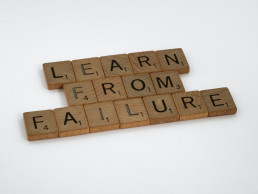The Art of Business Development: Navigating the Non-Linear Path to Success
At Bizydev, we take pride in generating opportunities for our clients. Our approach is more relationship-driven and vetted, which may not always produce immediate results, but ultimately leads to meaningful partnerships and revenue generation.
We understand that business development is not a linear process, and there is an art to going to market. Our work at Bizydev comes in many shapes and sizes, and we can't always put KPI's around the role we play to explain a client's technology or product to the end user, partner, or other counterparty.
We do things that lead to revenue, but in many instances, our work is not direct. Our best work is done when we have a client that has something amazing and unique, as opposed to a commodity that the end user has been pitched countless times over.
At Bizydev, we believe that having a diverse and unique pipeline is critical to success in business development. While it may not be a linear process with startups, we work hard to connect the dots and find the right partnerships for our clients.
If you're looking for a business development partner that understands the nuances of the industry and takes a relationship-driven approach to generating opportunities, let's connect and see how we can help your business grow.
Strategic Investors and Value from Your Cap Table
Investors play a critical role in the venture ecosystem. Deploying capital based on the assessed potential of early-stage companies is elemental to the development of new ideas, products, platforms, and technologies. Even so, many startups expect investors to play a much bigger role than simply providing essential funding.
Here’s a question for you entrepreneurs: when raising capital, how would you describe your ideal investor? Is it strictly the person or firm who can provide an investment fastest or with the most favorable terms?
We would guess that, for at least part of your cap table, you aim to include investors who can be strategic. Those whose networks you can leverage, and whose expertise you can lean on when facing the inevitable challenges of growth. We know that some of the best investors in the market play that role and play it well. But we also see instances where companies are disappointed by the lack of partnership offered by investors who claim to provide value other than just money. In this article we take a closer look at where expectations between investors and entrepreneurs can be mismatched, and where explicit communication and thoughtful strategies in building your cap table can alleviate these pressures.
The Startup Perspective
Why do founders seek investors who can double as strategic advisors? This may seem obvious in some respects, but let’s break down some of the specifics and nuances.
Expertise. Investors typically have unparalleled experience regarding operating an early-stage business. Many Angels and VCs are former entrepreneurs themselves and have stewarded dozens of their investments through the most challenging phases of growth. To first-time founders and founding teams, this expertise can be invaluable. Whether through board participation or informal involvement, it is easy to imagine how a tenured investor can help keep you on the right track.
Network. Investors’ personal and professional networks are another key selling point. Investor networks often include executives at large potential customers, go-to-market partners, and other investors who can bring in additional capital. For entrepreneurs with a limited network and limited time to build it, a well-connected investor can feel like the missing puzzle piece.
Validation. Finally, landing a highly successful and respected investor can be a mark of validation for a new venture. Prospective users may see buy-in from a top investor as a strong endorsement of your product or service. Later-round investors may also look to your initial cap table as a means to better validate your business’s potential.
The Investor Perspective
Many investors recognize the value they bring to early-stage companies beyond funding alone. They see their know-how and networks as differentiators to both win deals and help grow their portfolio companies. However, startups often fail to recognize that any investor has a multitude of demands on their time and attention. Consider this: according to FundersClub, the average VC fund is spread across 30 to 80 startups, and serving as a Directors or Advisors to their portfolio companies comprises only a portion of VC partners’ time. They are constantly focused on sourcing new investments, developing LP relationships and/or raising their next fund, executing exits with existing portfolio companies, and managing the day-to-day activities of their firms.
It is important to understand an investor’s strategic role in context – investors want to add additional value for entrepreneurs when it helps maximize their return AND when they have the availability to do so. They aim to provide impactful guidance at key inflection points, make a handful of targeted introductions, and offer a stamp of approval that a founder can leverage in the marketplace. This is not a critique of investors’ willingness to help, it’s more of an observational fact. To spend an outsized amount of time on a single portfolio company would require the abandonment of other equally, if not more, important responsibilities, not to mention the potential ramifications of materially favoring and supporting one portfolio company over another.
Addressing the Disconnect

When you consider the perspectives above, the potential for disconnect between entrepreneurs and investors is clear. Startups often seek investors that can play a considerable strategic role, and investors have limited capacity to play that role for multiple portfolio companies simultaneously. It’s not a dig at either side, it’s simply the nature of each party’s respective position.
So, founders, when you’re seeking your next VC or private investor, are you going to seek out someone who can bring more than capital to the table? We think you should, but here are a few ideas for how to align your needs and expectations so you can maximize the effectiveness of those on your cap table.
1) Make a plan to build your network of advisors and be thoughtful about where investors fit into that network, keeping in mind how they may be impactful later down the road. As your company progresses, you’ll eventually form a Board of Directors composed primarily of members of the founding team and major investors. Since board members will help set the direction for your company, you want to make sure that you have solid pre-existing relationships with all investors who may eventually be granted a seat. Adding lead investors to a Board of Directors is more-or-less inevitable and typically a board seat will be included in the investment terms you’ll receive. However, if you’re considering carving out a Board seat for an Advisor or minority investor, our recommendation would be to only bring on anyone who has already proven their value.
2) Communicate your goals for the investor relationship and where you envision their help playing a critical role. Identify specific companies or individuals in the investor’s network that you aspire to get in front of, or offer guidelines around the types of introductions you hope they can make. Try to focus on where an investor can make the biggest impact while minimizing the demand on their time.
3) Be realistic about the validation that comes from a specific investor relationship. Some investors’ track records may stand out, but no investor has entirely avoided making mistakes – investors are only human after all. Your product or service must be able to stand on its own; backing by a great investor can be a powerful marketing tool but it can never replace a proven product-market fit.
In a way, Bizydev, by nature of what we do, is better positioned to be the hands-on strategic partner that entrepreneurs often seek in an investor. We recognize better than anyone the value of a partner who can immediately understand your business and get you in front of the right opportunities at exactly the right time. We also recognize better than anyone how much time, commitment, thought, and effort it takes to play that role effectively for multiple startups concurrently. Communicate directly with your potential investors about how big of a strategic role they can play and you’ll build much more rewarding relationships in your cap table. And if you find yourself in need of a business development partner who is focused on going the extra mile to bring you industry expertise, a vast network, and a strategic helping hand, you can always drop us a line.
Fighting the Great Resignation: What Companies are Doing Today to Retain Talent
The Great Resignation. Honestly, this sounds like a pretty scary proposition for employers and business owners. Although no one can deny the effect the pandemic has had on current work practices, this newfound importance placed on work-life balance isn’t going anywhere. Rather than being the scary proposition it could be, many companies are combating this talent exodus by finding ways to bring new value not just to the work of their employees, but to their lives as well.
Flexibility
 Anthony Klotz, the Texas A&M management professor who coined the term “the Great Resignation,” recently spoke with CNBC and shared that “the pandemic brought the future of work into the present of work…we are not going back to the work of 2019.” Business owners who simply think they are going to be able to bring their employees back to the way things were are going to get left behind. According to a recent LinkedIn poll, 63% of respondents claimed work-life balance is their top priority when finding a new job, and the Workhome Project found that people value flexibility as much as they do a 10% raise.
Anthony Klotz, the Texas A&M management professor who coined the term “the Great Resignation,” recently spoke with CNBC and shared that “the pandemic brought the future of work into the present of work…we are not going back to the work of 2019.” Business owners who simply think they are going to be able to bring their employees back to the way things were are going to get left behind. According to a recent LinkedIn poll, 63% of respondents claimed work-life balance is their top priority when finding a new job, and the Workhome Project found that people value flexibility as much as they do a 10% raise.
It should come as no surprise then that companies are shifting to hybrid and remote models that provide more benefits than the old in-office adage of “we’re a family here.” The talent pool drastically increases when shifting to a pure remote model, adding opportunities not just for employees who may have been landlocked from their dream jobs, but for employers as well to create a more diverse and skilled employee pool. And flexibility doesn’t just mean where you work, but how and when. Accessibility has become a focus in interviews and workplace structure, and when applied appropriately, results in a workforce who is living to work, not the other way around.
Culture
We are not suggesting the office is going away forever, in fact quite the opposite. The office now needs to serve a different purpose in the life of your employee. In speaking with Marc Spector, FAIA and Principal/Owner of Spectorgroup, a recent Bizydev client, he said “companies need to create a cultural, hospitality-driven experience in the workplace that is more compelling than that of the home office. Cultural capital is the new office currency” and this trend is here for the long-haul.
 In terms of office layout, companies are experimenting with more open concepts, from activity-based workspaces, to coworking spaces, and hotdesks (where no one in the office, even the C-suite has their own personal desk), all with the goal of creating more options for workers regarding getting their work done. Even more extreme, some companies, especially in the tech sector on the east coast, are experiencing what can only be referred to as the “San Francisco-ization” of the office. Offering amenities such as free meals, lounge spaces, recreational activities, and beer taps, the companies that are approaching this new trend from the perspective of getting employees to “want” to, rather than “need” to, be in the office are the ones that are going to win this battle.
In terms of office layout, companies are experimenting with more open concepts, from activity-based workspaces, to coworking spaces, and hotdesks (where no one in the office, even the C-suite has their own personal desk), all with the goal of creating more options for workers regarding getting their work done. Even more extreme, some companies, especially in the tech sector on the east coast, are experiencing what can only be referred to as the “San Francisco-ization” of the office. Offering amenities such as free meals, lounge spaces, recreational activities, and beer taps, the companies that are approaching this new trend from the perspective of getting employees to “want” to, rather than “need” to, be in the office are the ones that are going to win this battle.
Employee Wellness
The pandemic has been mentally taxing on most, and with this came a shift in focus in the way people are thinking about their wellness. Mental Health became a much bigger focus during the pandemic, and employers who are providing support in these areas now have a big leg up on the competition. In Mercer’s 2021 Health on Demand report, 42% of employees with access to mental health benefits reported that they’re more likely to stay at their current organization than if they didn’t have those resources. They also found that 44% of those without access to mental health benefits did not feel supported by their employers.
the pandemic, and employers who are providing support in these areas now have a big leg up on the competition. In Mercer’s 2021 Health on Demand report, 42% of employees with access to mental health benefits reported that they’re more likely to stay at their current organization than if they didn’t have those resources. They also found that 44% of those without access to mental health benefits did not feel supported by their employers.
Now there are many ways employees can further their efforts in these areas. New health and wellness initiatives are being brought to companies every day. From company-wide fitness platforms, to providing mental health days, to the aforementioned workplace flexibility, and to wellness retreats, these are just some ways employers are trying to create a healthier experience for their workers. It is more than just adding perks to the workplace however, it is the true intent by company leaders and their commitment to a healthier life for their employees that will truly make a difference.
What Now?
It is definitely an uncertain time for business owners. With the job pool ever expanding thanks to remote work, a change in mentality when it comes to what actually matters in the workplace, and a workforce that has demonstrated they are willing to move on if their needs are not met, this is a time for leaders who can empathize to take advantage of this opportunity to create the most well-rounded workplace.
Tech Trends: What's in Store for 2022
From an innovation standpoint, the past couple of years were full of dramatic and transformational change and we do not expect 2022 to be any different. We’re particularly excited about the changes happening in PropTech, Health and Wellness, and Retail, as we have been busy engaging new clients in all of these verticals.
PropTech

In PropTech, we expect to see continued emphasis placed on the use of technologies that help customers and businesses visualize and experience their spaces in the digital world (e.g., AR/VR, visualization, advanced 3D rendering). During 2021, we saw the rise of virtual Real Estate as the wider world was introduced to metaverse platforms like Decentraland and The Sandbox, and our opinion is that this was just the start. We believe that advances in AI will allow this evolution to proliferate even faster as development engines and deep-learning algorithms are able to take user-specified metrics and requirements and automatically generate robust designs and finished building environments.
Take our current client Qbiq as an example. The Company utilizes proprietary AI and advanced rendering techniques to design finished office floor plans in minutes, uniquely tailored to a customer’s specific needs. With private investments in PropTech up 28% YoY, this sector is going to continue to explode and Bizydev’s expertise in real estate positions us perfectly to take advantage.
Health & Wellness

On the Health and Wellness front, we know that remaining healthy will remain a top priority for people in 2022 as we cautiously emerge from the COVID19 pandemic. While we could focus on a variety of trends here, we are most excited about the opportunities in the realm of connectedness, on both an interpersonal and technological basis, particularly as we see more and more people transition to remote-work-friendly lifestyles. Ecosystems that enable and support distributed communities by allowing users to stay connected around the globe, interact with specialists and professionals, compete with their friends to achieve goals, and the like, will ultimately lead to better outcomes across an array of disciplines (e.g., fitness, mental health, weight management).
Supporting this will be the continued proliferation of smart, connected devices that enhance the health and wellness experience in the home and provide users useful and impactful data. Whether it be connected fitness (iFIT), smart sleep systems (Eight Sleep), or fitness trackers (Whoop, Oura), we are now able to gain real-time insights concerning all aspects of our daily well-being and performance. It won’t be far off until we see the interconnectedness taken to the next level whereby these devices are all able to communicate and exchange data with one another, effectively comprising a single, holistic platform empowering individuals to live healthy and productive lives with minimal effort.
Retail

For Retail, we anticipate that the convergence between brick-and-mortar and digital channels will accelerate as the broader use of in-store automation and contextual analytics at the edge bring us closer to a unified, and highly-personalized, omnichannel shopping experience. Throughout 2021 and already into 2022, we have seen big-box retailers like Walmart, BestBuy, and Walgreens launch internal retail media networks to capitalize on the burgeoning “store as a medium” opportunity–think targeted ads on digital signage as you pass by or individualized promotions pushed to your phone while shopping all driven by customer datasets comprised of comprehensive in-store and online data–which has been enabled by these new technologies.
Another embodiment of this trend can be seen in the work being done by our client Brik+Clik, who is shaping the future of retail by bringing the convenience of online while allowing consumers to touch, feel, taste and try-on their favorite brands in a real-world environment. The benefit to the shopper is clear, but Brik+Clik is also changing the game for D2C online brands who now have a capital-light, data-driven, white-glove alternative to establishing their own physical retail presence. Instead of Location, Location, Location, for physical retailers, it’s becoming Data, Data, Data.
Think Twice Before the BCC
At Bizydev, we believe that business development is a crucial but often overlooked resource in the early stage startup market. Our founding principle was to provide clients with a complete range of business development services, from growth and acceleration advice to building out their pipeline with new connections. One of our key responsibilities is to make new connections for our clients, introducing them to potential customers, strategic partners, capital sources, and more. However, we’ve noticed that some clients have been tempted to remove us from the conversation or BCC us once we make these introductions by email.
We understand the importance of B2B relationships and fostering connectivity, but we’re committed to the success of our clients and want to see these collaborations come to life and flourish. By moving us from CC to BCC, you’re limiting the full impact we can bring to the table.
At Bizydev, we don’t just approach business development as an introduction service. We want to be an extension of your team, providing guidance around the customers and partners we bring to the table. We want to be included and consulted throughout the process, so that we can monitor and steer your business towards your goals and objectives.
Don’t worry about cluttering our inboxes – we want to stay engaged with our clients and be a part of their journey towards success. At Bizydev, we’re not just an outsourced accelerant, we’re a committed partner. So, going forward, include us and consult us throughout the process, because that’s what we’re here for.
If you’re looking for more information on how we approach business development, check out the Bizydev Services which provide an overview of how we work with and help our clients.
And if you are looking for more research and when and when not to use cc and bcc check out this article on Email Etiquette 101 by B12.
CIScount: The Evolution of Pricing Retail Space
Not too long ago, the only retail space was physical retail space – commonly and misleadingly referred to as “brick-and-mortar.” These spaces range from high-end boutiques to big-box stores to everything in between.
Today, there are two types of retail space: the physical retail space and the virtual retail space – aka the websites and mobile applications where so much of modern commerce takes place. Stakeholders value retail space, regardless of whether it’s physical or virtual, because it provides a venue for customer decision-making, brand loyalty-building, the showcasing of products, and the selling of goods.
However, most methods the real estate industry uses for deriving physical retail space value don’t take virtual transactions into account. Instead, they base physical retail pricing exclusively on transactions that are completed inside the physical store. Traditional retail leases utilize either base rent (which is supply and demand oriented) or percentage rent (where a landlord takes a certain percentage of in store sales), which are generally not adapting well to the age of virtual space.
These methods don’t necessarily recognize where new value creation opportunities exist or spaces where value already exists that is not being captured. Commercial real estate stakeholders including retailers, real estate owners, investors, lenders, and brokers who are all involved in structuring leases are all negatively impacted by this problem.
Quantifying the value of physical retail space is especially important in the post-COVID real estate market. During the pandemic, traditional retailers pivoted, enhanced their digital presences, and found a new balance between virtual and physical retail spaces. In the post-COVID world, most retailers who were not able to adjust to changing times either broke their leases, went out of business, or both. As a result, there is now a greater amount of vacant retail space in the marketplace than there has been in more than a decade.
But change is on the horizon. New systems for pricing retail real estate are gaining popularity.
One new method, CIScount, measures customers-in-store via technological innovations such as in-store foot traffic trackers. CIScount is an innovative way of determining retail rent that can work better than either traditional base rent calculations (which have fairly fixed methodologies) or percentage rent calculations (which have difficulty in attribution).
CIScount is inspired by Bizydev’s work with client Dor Technologies, who have developed a cost effective thermal sensing, battery-operated, peel & stick foot traffic counter for retail stores.
Bizydev, which created CIScount, actively works with clients in the PropTech and Retail sectors on business development and growth initiatives. Co-founder Jonathan Fishman has a long history of creating value and growth opportunities for partners in the real estate sphere and of utilizing technology to help traditional industry norms evolve.
Here’s a little bit about what Bizydev sees around the corner:
Better Determining The Value of Physical Retail Space
Steve Dennis, author of the 2021 book Remarkable Retail, notes that digital channels are now a key part of the consumer’s journey. However, Dennis notes that--contrary to the naysayers--people are still shopping in stores.
Even after the disruptive year of 2020, when many customers switched to digital venues, customers still flock to retail stores for practical (seeing products in person, returning purchases, in-store only sales) and experiential (having an experience they can’t have at home or remotely) reasons. This means that in 2021 and beyond, stakeholders must understand just how interconnected virtual and physical retail spaces are.
For traditional commercial real estate stakeholders, the ultimate measure of valuing retailer health was the correlation between base rent, exterior foot traffic, and gross in-store sales. However, with the rise of virtual spaces, traditional metrics for understanding physical space wellness like exterior foot traffic have been thrown by the wayside.
Furthermore, gross sales are increasingly unrealistic for determining physical retail value because we live in a post-omnichannel world. Customers frequently begin their purchase journey in physical retail spaces before completing their transaction virtually, and vice-versa. But this customer behavior doesn’t necessarily translate into how commercial real estate is priced and valued.
While today’s retailers generally understand the impact of customer value on their virtual space, they may not understand the impact of customer value on their physical space. Retailers working in virtual spaces are better able to determine customer acquisition cost, and price their online advertising and marketing spend in systematic and deliberate ways. By comparison, most of the lease structure methodologies used for physical retail pricing don’t afford retailers or retail owners the same flexibility that exists in the online world.
Despite the fact that 71% of shoppers spend more time in physical retail space versus virtual ones (First Insight, 2019), accurately tracking in-store foot traffic, customer in-store behavior, and in-store decision-making has been extremely difficult until relatively recently. But thanks to technological advances like Dor, it is far easier.
This is especially important in the contemporary retail real estate landscape as retailers and landlords determine new rent lease payment structures that they believe better aligns with each of their interests. In 2020, many retail leases were modified to accommodate the pandemic situation by replacing base rent with percentage rent as the premier methodology for calculating rent payment.
For instance, the Wall Street Journal says retailers and landlords are currently clashing over the definition of a “sale” with customers increasingly browsing in-store but completing purchases online. Landlords who modified leases and thought they had drafted the right lease language were surprised to see shortcomings in their attribution methods due to omnichannel.
However, CIScount helps resolve this shortcoming by striking a better balance between physical and virtual retail spaces. While existing metrics and pricing models used in virtual spaces already take conversion rates and non-converting online traffic into account, CIScount is a physical metric equivalent that helps determine both visitor activity and true customer lifetime value. As a metric for lease pricing, it works well for both sides and provides added flexibility for the post-COVID world.
The CIScount not only has the potential to add to gross sales measured by a store’s POS, but also represents future sales for both physical and virtual retail spaces. Whereas an individual store’s gross sales represent just POS sales and nothing more, the CIScount applies to future sales across all of the retailer’s spaces whether physical or virtual. CIScount is simple, straight-forward and not subject to negotiation, interpretation and differing interpretations.
According to retail real estate lawyer Buddy Flateman, landlords and retailers have been struggling for years attempting to properly value retail real estate. While “sales volume” will always be the defining metric, there is an awakening of a new generation of retail professionals to the dual facts that (1) physical retail space and virtual retail space not only play on the same team, but need each other to generate sales, and (2) it is no longer possible to pinpoint how, when and where these sales are generated. So while store sales were once a fairly precise measure of the value of physical retail space, that measure is today not only inaccurate but often misleading. And though CIScount may not tell the whole “value story”, it will not only tell an awful lot on its very first day, but tell more and more over time as retailers learn to correlate the CIScount with their other value metrics. And moreover, just like POS sales figures from our “prehistoric” past, CIScount is straightforward math – there is no argument over definition or audit over application.
CISCount, Physical and Virtual Retail Spaces
Traditionally, retail foot traffic has been measured outside stores and not inside stores. Heavy foot traffic on busy urban avenues or in shopping malls is viewed as a reliable estimation tactic for customers going in and out of stores, but in-store foot traffic has not generally been used as a metric for retailers or real estate owners determining rent pricing.
Technical innovations change that. Dor’s product, for instance, is a thermal sensing, battery-operated foot traffic counter with peel-and-stick backing for easy installation in retail stores. Retailers place Dor sensors above their entryways, and the sensors then track foot traffic into the store. Depending on individual customer needs, users can track foot traffic stats and trends across store locations, track conversion rates (via simple one click integrations with most POS systems) for purchases based on day or time, and combine Dor’s data with other retail tools. In addition, CIScount data can be shared by retailers and real estate owners so both can better understand the current health of a store and forecast potential rent for the month.
This applies in a wide range of physical retail settings. For instance, Bizydev has a close relationship with Storefront, a company which matches brands with temporary physical spaces. Both established and newer direct-to-consumer brands selling primarily over the internet have found pop-up stores useful for both generating buzz on social media platforms and boosting sales from customers who would otherwise be on the fence. For pop-up tenants pricing temporary spaces, CIScount is a methodology which can emphasize customer exposure or experiential marketing as opposed to in-store sales.
CIScount in pop-up use cases is especially useful because temporary store openings are often just as much about presence and marketing as they are about selling products in the physical space. If an Ecommerce brand leases a pop-up space for an in-person experience, stakeholders using CIScount are the most equipped to understand the value of a customer-in-store.
As retailers head into a post-omnichannel future where virtual and physical retail spaces integrate seamlessly and delineating specific channels becomes challenging, CIScount makes it easier to price commercial rent and gain market traction.
In addition to retail real estate valuation, Flateman finds an even more compelling justification to focus on CIScount: A new universe of operating information for the retailer. For example, CIScount will facilitate decisions involving staffing levels, efficacy of store management and personnel, marketing efforts, signage, store appearance, and merchandise offerings.
As the retail real estate market rebounds post-COVID, value-add acquirers of real estate could end up valuing properties with CIScount-based retail leases in place in a unique way. Instead of underwriting rental growth simply tied to fixed escalations or market improvement, a new owner could project various creative marketing strategies they could implement to drive more customers to the stores and ultimately generate more lease revenue.
Methodologies like CIScount allow retailers and real estate owners to both test out new marketing strategies for driving customers into stores and allow creative teams to retrofit their stores in ways that make brand presences more experiential.
Fixing the Attribution Problem
The retail and real estate industries are at a crossroads where both must find solutions that better align with their interests. CIScount creates that balance, meaning that brands which have calculated the value of a customer online can now begin to determine the value of a customer in store.
Naturally, physical retail isn’t going anywhere. Customers want to touch, try on, and experience merchandise in-person. This has always been physical retail’s advantage, and will always be something that draws customers in. That said, using CIScount, stakeholders can negotiate retail rent which more accurately reflects the value of their properties.
Bizydev is at the forefront of introducing new concepts and methodologies that allow the retail and real estate industry to evolve and adapt. Our work with clients centers on helping technology, product, and service companies accelerate growth and develop the right types of opportunities. We'd love to find ways to work with your organization.
Emotional Intelligence and Business Development
Judging from my short stint as an associate at a business development firm, this industry is not for the introverted or antisocial. It requires, most principally, the ability to communicate and connect with people across different sectors and over different platforms. If you’re unwilling to do so, you probably won’t make it very far. The business development industry is fundamentally an industry of connections. Thus, successful examples of business development most often come from people willing to engage with others.
But, there are millions of extroverts around the world, so what separates the best communicators from the average? The answer: emotional intelligence. Naturally, everyone would like to think that they’re as emotionally intelligent as they can be and that they possess all the skills necessary to be a great communicator. In many cases, unfortunately, their self-images are overstated. True emotional intelligence is not only the ability to read, understand, and react to other people’s emotions, but it’s the ability to analyze your own emotions and reign them in or properly convey them.
It seems obvious where these skills would play into business development. In an industry where establishing relationships and networking is paramount to your success, a high level of emotional intelligence is almost a shortcut to the finish line. So shouldn’t a skill that can minimize miscommunication issues, endear you to a necessary business connection, and help you analyze your own goals be developed as much as, if not more than any other skill? I think so.
If you choose to believe that emotional intelligence is a quality that is necessary to successful business relationships, then you might also be wondering how you can improve it. I have found that the best way to develop your emotional intelligence is practice. Make more deliberate efforts to reach out to potential connections, have more coffee chats, attend more conferences. And, while you do so, be mindful of your own behavior. Take note of how you phrase things, make an effort to show that you’re listening, even making eye contact will help you better understand your counterpart. The misconception that emotional intelligence is simply the ability to read others is where most people fall short. Self-awareness is key to productive relationships, and it needs to be a quality more present in the business world.
Emotional intelligence is an important part of Bizydev’s approach to their service. We maintain that sincere, mutually beneficial partnerships are key to business growth in any industry. By ensuring that our relationships and the relationships that we help establish between other firms are conducted with a high degree of emotional intelligence, we are setting ourselves and our associates on a path to success.












